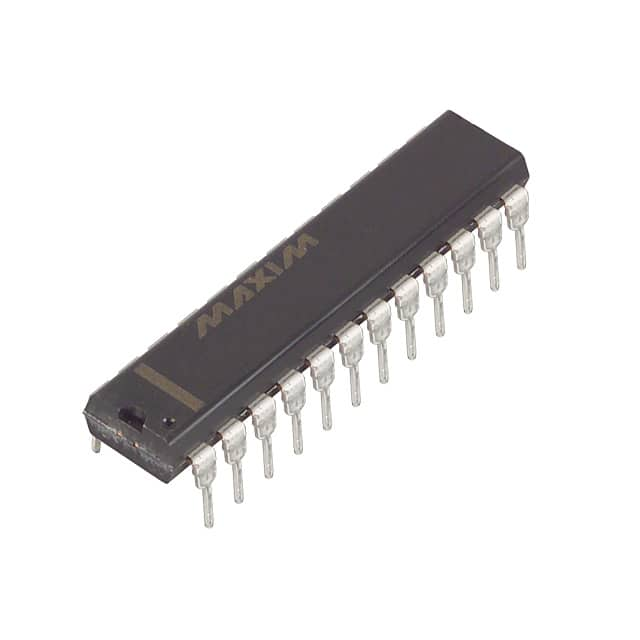MAX128BCNG
Product Overview
- Category: Integrated Circuit (IC)
- Use: Analog-to-Digital Converter (ADC)
- Characteristics: High-resolution, low-power consumption
- Package: DIP (Dual In-line Package)
- Essence: Converts analog signals to digital format
- Packaging/Quantity: Tray packaging, 25 units per tray
Specifications
- Resolution: 12 bits
- Sampling Rate: 100 kilosamples per second (ksps)
- Input Voltage Range: 0V to Vref
- Power Supply Voltage: 2.7V to 5.25V
- Operating Temperature Range: -40°C to +85°C
Detailed Pin Configuration
The MAX128BCNG has a total of 28 pins. The pin configuration is as follows:
- VDD: Power supply voltage input
- VREF: Reference voltage input
- AGND: Analog ground
- REFOUT: Reference voltage output
- IN0 to IN11: Analog input channels
- CS: Chip select input
- RD: Read data output
- WR: Write control input
- ALE: Address latch enable input
- CLK: Clock input
- ADD0 to ADD3: Address inputs
- DGND: Digital ground
- D0 to D7: Data bus
- BUSY: Conversion in progress indicator
- EOC: End of conversion indicator
- INT: Interrupt output
- RESET: Reset input
- NC: No connection
Functional Features
- High-resolution ADC with 12-bit resolution
- Low-power consumption for energy-efficient operation
- Fast sampling rate of 100 ksps for real-time data acquisition
- Wide input voltage range allows for versatile signal conversion
- Reference voltage output for external reference use
- Conversion in progress and end of conversion indicators
- Interrupt output for efficient system control
Advantages and Disadvantages
Advantages
- High resolution provides accurate digital representation of analog signals
- Low-power consumption helps conserve energy and extend battery life
- Fast sampling rate enables real-time data acquisition
- Wide input voltage range allows for versatile signal conversion
- Reference voltage output offers flexibility in using external references
Disadvantages
- Limited to 12-bit resolution, which may not be sufficient for certain applications requiring higher precision
- DIP package may limit space-saving options compared to smaller surface-mount packages
Working Principles
The MAX128BCNG is an analog-to-digital converter that converts continuous analog signals into discrete digital values. It utilizes a successive approximation register (SAR) architecture to achieve high-resolution conversion. The analog input voltage is compared to a reference voltage, and the converter determines the digital value by iteratively approximating the input voltage through a binary search process. The converted digital value is then made available for further processing.
Detailed Application Field Plans
The MAX128BCNG can be used in various applications that require analog-to-digital conversion with moderate resolution and low power consumption. Some potential application fields include:
- Industrial automation: Monitoring and control systems that require precise measurement of analog signals.
- Data acquisition: Real-time data logging and analysis systems that need to convert analog sensor readings into digital format.
- Medical devices: Instruments that measure physiological signals and require accurate digitization for diagnosis and treatment.
- Communication systems: Analog signal processing in telecommunication equipment, such as modems and voice/data transmission devices.
- Test and measurement: Equipment used for testing and measuring analog signals in laboratories and production environments.
Detailed and Complete Alternative Models
- MAX1232BCNG: Similar to MAX128BCNG, but with 12-bit resolution and a different pin configuration.
- MAX129BCNG: Higher-resolution ADC with 16-bit resolution and similar pin configuration to MAX128BCNG.
- MAX127BCNG: Lower-resolution ADC with 10-bit resolution and similar pin configuration to MAX128BCNG.
These alternative models offer different resolution options and can be chosen based on specific application requirements.
Word count: 525 words
Lista 10 Vanliga frågor och svar relaterade till tillämpningen av MAX128BCNG i tekniska lösningar
Sure! Here are 10 common questions and answers related to the application of MAX128BCNG in technical solutions:
Q: What is MAX128BCNG? A: MAX128BCNG is a 12-bit analog-to-digital converter (ADC) integrated circuit that can convert analog signals into digital data.
Q: What is the operating voltage range for MAX128BCNG? A: The operating voltage range for MAX128BCNG is typically between +5V and +15V.
Q: What is the maximum sampling rate of MAX128BCNG? A: The maximum sampling rate of MAX128BCNG is 100 kilosamples per second (ksps).
Q: Can MAX128BCNG be used in battery-powered applications? A: Yes, MAX128BCNG can be used in battery-powered applications as it has low power consumption.
Q: Does MAX128BCNG support multiple input channels? A: Yes, MAX128BCNG supports up to 8 single-ended or 4 differential input channels.
Q: What is the resolution of MAX128BCNG? A: MAX128BCNG has a resolution of 12 bits, which means it can provide 4096 discrete digital output levels.
Q: Is MAX128BCNG suitable for high-precision measurements? A: Yes, MAX128BCNG is suitable for high-precision measurements due to its low noise and excellent linearity.
Q: Can MAX128BCNG operate in harsh environments? A: MAX128BCNG has a wide temperature range and can operate in harsh environments, making it suitable for industrial applications.
Q: Does MAX128BCNG require external reference voltage? A: Yes, MAX128BCNG requires an external reference voltage for accurate conversions.
Q: What are some typical applications of MAX128BCNG? A: Some typical applications of MAX128BCNG include data acquisition systems, industrial automation, medical instrumentation, and process control.
Please note that the answers provided here are general and may vary depending on specific product specifications and requirements.


